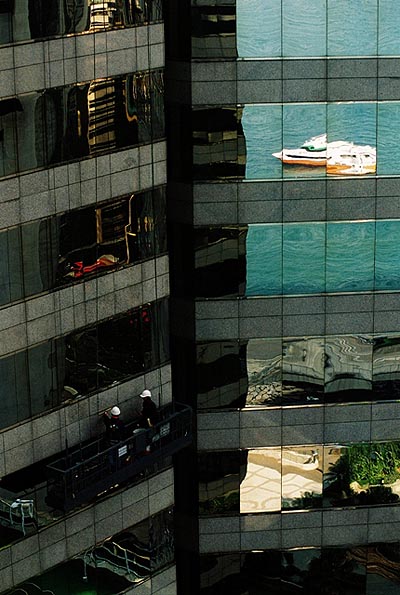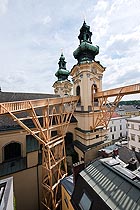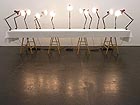
translated and summarized by: Liz Wollner-Grandville,
English summaries July 12 - 24
BAWAG Contemporary
Franz Graf – “Derr Schrecken jedoch vermeerte mein Interesse”
07.07.11 – 28.08.11
Darkroom in protective foil
The title is as irritating as it is characteristic for Franz Graf’s current exhibition at the Bawag Contemporary. The artist curated, hanged, and staged his darkest show ever. Alone the flower-shaped ball with leftovers of red tape breaks through the black formalism. Franz Graf presents a new facet with his partly large-format works, created especially for this exhibition. The ornamental and abstract is pushed aside, individual aspects only remain as reminiscences, a peculiar striking affinity to fetish emerged.
Franz Graf discloses a very personal realm of experience involving heavy, and partly abysmal, topics. Women’s bodies are enchained, scarred by tattoos and cross-shaped signs, their faces covered with black ink. Sexuality, lust, suffering, pain, defenceless nudity, which goes beyond the corporal dimension and takes control of the psyche and soul, are manifested as immediately experienced moments and eternally interlocked. The depictions are elevated from a subjective to a universally valid dimension through an extensively painted disguise and imposed formalisation and thereby present a significant aspect of human existence.
But this only apprehends part of the “new” Franz Graf complex. The installation showing a combination of grave crosses, lying on a palette, and the remaining black garbage bags attempt to make it clear that the topic goes beyond bondage or sadomasochistic practices or the determination of human existence and that it has more of an essential nature.
If one detaches oneself from the individual works and concentrates on the main installation with its special immersive totality, the superficial presence of sexuality seems to collapse and a strong transitory moment dominates. Religiousness, which plays an important role in the Waldviertel, Franz Graf’s current retreat, becomes omnipresent – not as the Catholic denomination but as an abstract, metaphysical context. The cross-shaped signs and black surfaces, penetrating the portraits and women’s bodies, have a clear relationship to the grave crosses, which seem to have been placed on the palettes temporarily. They not only become essential in their function as a temporary base but also as a means of transport. The black plastic foil, hanging from the paintings, has a skin-like appearance, which supports the lasciviousness and at the same time offers protection or will offer protection from a glance, a grip, or packaging for transfer. The associative spiritual context is underlined by positioning the installation as the main theme under a glass roof on the middle room’s lower level. Writings on the paintings - such as PURGA (Latin: cleanse) or LINERZIA DEL CUORE (Latin: phlegm of the heart) - provide a feature that points to the ideal sphere, superior to all worldly.
The exhibition may be interpreted as a very personal comment by Franz Graf: as the staging of human existence as a temporary condition, merciless in expression and content, but simultaneously defined as a transitory moment in an expanded, transcendent connection.
By Margareta Sandhofer
Bawag Contemporary
1010 Vienna, Franz Josefs Kai 3
www.bawagcontemporary.at
Opening hours: daily from 2 p.m. – 8 p.m.
Galerie Michaela Stock
Franz Wegner – Hong Kong – Moments of Silence
29.06.11 – 22.08.11
When silence tells stories
Two chains, no, three. Behind them - somebody on his knees, bowing to mother earth. One has to glance at this twice, or even thrice. And then, magically, an Asian scenario develops. Someone praying in a temple. In Hong Kong. A captured moment of silence, Frank Wegner succeeded in doing so. The German photographer, famous for people and animals whose heads are not visible, erotic allured flowers, presents his “Street Photography” (the term is not really appropriate) at Michaela Stock’s gallery. A show called “Moments of Silence”, appropriate, because the pictures extract themselves from the Hong Kong hustle and bustle, less appropriate, because it deals with extremely eloquent moments. Moments that tell stories – when offerings and the pictures of deceased contrast in a shrine of life and death, or in black-white-grey and colour. Or when a boat on the water suddenly passes the fifth floor of a skyscraper – as a reflection. Frank Wegner has an eye for a special situation that not only exists, but goes beyond itself. Photo art without pretentions, but definitely art.
By Gerhard Charles Rump
Galerie Michaela Stock
1040 Vienna, Schleifmühlgasse 18
Tel.: +43 1 920 77 78
Email: info@galerie-stock.net
www.galerie-stock.net
Opening hours: Mon – Fri 3 p.m. – 7 p.m., Sat 11 a.m. – 3 p.m.
O.K. offenes Kulturhaus Oberösterreich
HÖHENRAUSCH.2 / Thrill of the Heights. – Bridges in the Sky
13.05 11 – 16.10.11
High flight and inner temptation
What was an absolute magnet for the public at its premiere shouldn't crash to the ground when launched again: "High Altitude Euphoria", spectacular course in and above the Open House of Culture in Linz was the strongest high-flyer in the year as European Culture Capital 2009 and, with 270,000 visitors, still ranks as the most prominent exhibition of modern art. After almost only eight weeks, "High Altitude Euphoria 2" can boast an attendance of 75,000 visitors, and the trend is rising….
With "HR.2", the OK presents 45 projects by 51 artists from 17 nations. With the focus on the themes of water and air, the team under director Martin Sturm has regenerated anew the supervisionary access to the area above Linz's city center.
Art doesn't any longer have to clamber up a beguiling stairway to heaven when it is in need of redemption; benevolent bridges of solidarity have been erected downwards from the roof and both steeples of the Ursuline Church, which is part of the ambitious leisure and adventure park. The church room beneath it houses a sound installation by Janet Cardiff and George Bures Miller.
And the venturesome construction of the two airy jetties (Conzett, Bronzini, Gartmann) is now not simply only one of the highlights for the amazed part-time carpenter. Even just below the clouds, the freedom of art is without boundaries; in thin air, the engineer's handiwork can easily overflow into the brainwork of the artist, oriented and free, applied (to life) and turned away (from life) becoming indistinct in the consonance of mixed feelings.
Apropos: In the rather restrained gait to the church there's an unmistakable feeling of butterflies in the stomach and weak knees which, amongst other things, the exhibition wanted to target: because each half-ethereal, seeming rustle and swish which comes out of the innermost ear and the depths of the entrails, floating in giddiness, catchword of the innermost bastard. And one almost feels secure in the lap of the church, which always wanted to be a tower.
The visual offerings of the work are impressive even if part of it appears to be stored in a "Blue Cabinet". Pipilotti Rist's percussive smoke bubble soap bubble machine counts as one of the absolute highlights, Ursula Stalder's stricken affluence and daily scrap iron from the Lagoon in Venice or Pepi Maier's snake-like entity in Baroque whorls made of ice.
In any case, one shouldn't ignore the Power Tower of Energie AG Upper Austria which is an outpost of the OK where one unavoidably meets Eva Schlegel's cloud made out of 1,200 water balloons, Werner Reiterer's self-portrait as an aeronaut who has gone up to the ceiling, and, and, and ………..
And the peaceful pavilion by Jeppe Hein built of water, nozzles and masses of fun is put into the shadow of doubt by the fog sculpture of the Japanese artist, Fujiko Nakaya (born 1933!): developed in the 70's as an idea, swathes rise from the roof of the neighboring garage, fray and scatter, suddenly recede into entry and exit and then push forward into the air space over Linz and are no longer expelled from the recently discarded nimbus of "steel city".
Spontaneously, but therefore all the more emphatically, they flare up - the surreal pictures of horror scenes of the atomic nightmare in Japan - poise like a deceptive glittering veil above the innocent-sensuous happening. And that will remain in the memory for a long time.
By Stephan Maier
O.K. offenes Kulturhaus Oberösterreich
4020 Linz, Dametzstrasse 30
Tel: +43 732 78 41 78
Fax: +43 732 77 56 84
email: office@ok-centrum,at
www.ok-centrum.at
Aargauer Kunsthaus
Mai-Thu Perret / Christian Rothacher
14.05.11 – 31.o7.11
Mai Thu Perret meets Christian Rothacher in Aarau
Up to the end of July, a special rendezvous is still waiting for your discovery in the Aargauer Kunsthaus: the "The Adding Machine" by the Geneva artist, Mai-Thu Perret, concurs with the retrospective of the Aarauer artist, Christian Rothacher.
On first viewing, both exhibitions do not appear to have much in common; the exhibits exist in the abundance of their underlying citations and cross-references.
Christian Rothacher (1944-2007) - one of the founders of the legendary artists' studio community in Ziegelrain in Aarau, which, from 1967 to 1975, was considered to be the pioneer of Swiss avant-garde - left a comprehensive oeuvre full of allusions, profound poetry and the highest technical perfection. The latter is demonstrated, for example, in the aquarelle of his many-layered plates of glass and his snow-covered patches of grass. Works by other Ziegelrain members, such as Heiner Kielholz, Hugo Suter, Max Matter and Markus Müller, can be found in the adjoining rooms and offer the possibility of seeing and evaluating Rothacher's work within the framework of its original context. In the 1970's, the proximity to Pop Art and Arte Povera in its early period is shown by what appear to be rare, surrealistic objects and bizarre drawings. When Rothacher quoted something, he availed himself of different alienation strategies but still retained the source of inspiration. Whether it's a wave captured in a clay plate by Hokusai, a blue-coloured blackboard with a sponge á la Yves Klein, a wayside cross made out of wooden rulers by C.D.Friedrich, or the reenactment of the Last Supper by Leonardo by means of simple desk lamps, again and again, Rothacher takes the risk of questioning the traditional stereotyped character of famous works in an ironic-critical way.
In contrast to him, and whose works don't negate the origin of the citation but rather are to be understood as a type of reflecting genre-transgressing reference procedure, Mai-Thu Perret (b. 1976) strives to sample with her "Adding Machine" - she understands her strategy to be a "simultaneous desire for the known and that, which is to come". Beginning with her leitmotiv "How do you do something that you have never done before?” Perret removes all existing barriers in order to mix everything with everything. To this end, the interview with the artist in Art Bulletin (6/2011) is both revealing and sobering. The result, presented in Aarau, is a multi-discipline conglomeration, which presupposes a "wide cultural and history of art referencing system" from the observer that the artist herself apparently possesses. The guidance given by the exhibition notes don't help much either, because Perret's allusions brusque only superficially with alleged references and are based on an encyclopedic interest which, roughly put, lead from Hilma af Klint to William S. Burroghs and from Enzo Maris Autoprogettazione to the post-modern décor of a Robert Venturi or Aldo Rossi. Because each reference triggers another reference and the observers come up with yet more, the entire Perret merit system is subject to a strong arbitrariness.
In one room, George Mathieus' fluid Rorschach painting meets that of the Lobster Telephone of Salvador Dali, in the next room, Claes Oldenburg's Walk-in Teapot meets Gerwald Rockenschaub's Neo-Geo painting. Naturally, pretty clay wall objects, "sculptural elements", are allowed to be projected onto a screen, and some decorative pieces of furniture, Op Art carpets and austere fluorescent lights which were apparently inspired by Piet Mondrian, are also present. The polyurethane foam copy of a jaguar from the meso-American Teotihuacán and a gilded Buddha form the bridge to the missing cultures, et violá: "The Adding Machine". Looked at singly, the statements and strengths of the works come into their own; in the succession of rooms, however, the progressive weaknesses of the whole concept become apparent. Admittedly, William S. Burroghs and Brion Gysin succeeded in re-arranging anew the principle of contingency with their re-mix technique of the "Cut-Up" assembly of pages of manuscript; but to declare this strategy as a principle in order to squeeze a few strong single works into an otherwise rather weak exhibition, doesn't suffice. Fortunately, there is a successful retrospective by Christian Rothacher on the ground floor.
By Harald Krämer
Aargauer Kunsthaus
5001 Aarau, Aargauerplatz
Tel: +41 62 835 23 30
Fax: +41 62 835 23 29
www.aargauerkunsthaus.ch
Opening hours: Tue – Sun 10 a.m. – 5 p.m., Thu 10 a.m. – 8 p.m.
Mehr Texte von translated and summarized by: Liz Wollner-Grandville


 Teilen
Teilen





